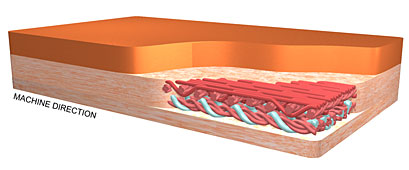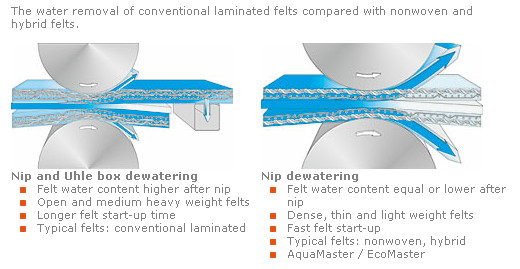Felts play a major role with regard to efficiency and cost savings. As the process is complex it is important to analyze the whole process, not only one part of it.
When purchasing a felt going for a cheaper option might, in the worst case, result in additional costs during the felt running time. It is better to analyze a felt’s real effect on machine efficiency by looking at the felt costs per produced paper tonnes and the savings (e.g. energy reduction and saved production time) that can be achieved with certain felts.

Energy savings through the right press felt choices
Big savings can be achieved by reducing energy costs in the paper machine. Electricity usage in the press section is huge and adds up to hundreds of thousands of euros every year. About 20-30% of electricity usage is related to Uhle boxes. Their friction increases the energy consumption of drives, and the Uhle box vacuum increases vacuum energy consumption.
Energy can be saved by using nonwoven and hybrid felts, which maximize nip dewatering meaning that minimized or no vacuums are required in the Uhle boxes.

Standard nonwoven and hybrid felts: AquaMaster and EcoMaster
AquaMaster’s immediately saturating structure allows a very fast start-up and maximal nip dewatering. As all the water is removed in the nip, Uhle boxes do not increase sheet dryness. Rewetting is minimized with a special layer.
EcoMaster is the combination of a woven and nonwoven structure. Its nip dewatering properties are excellent, but Uhle boxes can be used if necessary. Additional benefits compared with nonwoven felts include its smooth surface, insulation against marking, dimensional stability and less plugging.
Many machines already use AquaMaster and EcoMaster felts and run with maximized nip dewatering, which saves a lot of energy with closed vacuum pumps or blowers.
New: high-end TMO nonwoven and hybrid designs
Saving energy is not enough when the aim is to achieve efficient running. It is also important to improve runnability and total lifetime in other ways. In addition to good and even runnability, a minimal number of breaks, a high dry content and a maximal running speed are also important. A fast start-up and unchanged felt behavior are very important for the machine to run continuously at full speed. Minimal felt wear and a non-plugging structure ensure good life potential. A longer lifetime means fewer felt change shutdowns and savings in purchasing costs.
The sophisticated hybrid base TMO (TransMaster Open) felt has proven to be superior in this respect. It is a special felt for very demanding machines, such as highspeed printing paper machines.
Impregnated resin treatment ensures TMO’s even performance throughout its lifetime. This treatment makes the felt structure dense and non-compacting, and perfect for a fast start-up and immediate nip dewatering. The structure remains unchanged throughout the lifetime with no late life related problems such as edge flipping or plugging. Improved mechanical resistance gives the TMO felt long life potential and makes it durable, also under high nip pressures, even if the base fabric is nonwoven or hybrid.
The savings gained through making the right felt choices are significant. The picture on the next page shows an example of felt costs compared with savings achieved with the right felt choices.
The hybrid TMO felts are increasingly used in many of the world’s fastest newsprint and fine paper machines, especially in pick-up and 1st press positions, to ensure trouble-free running.
